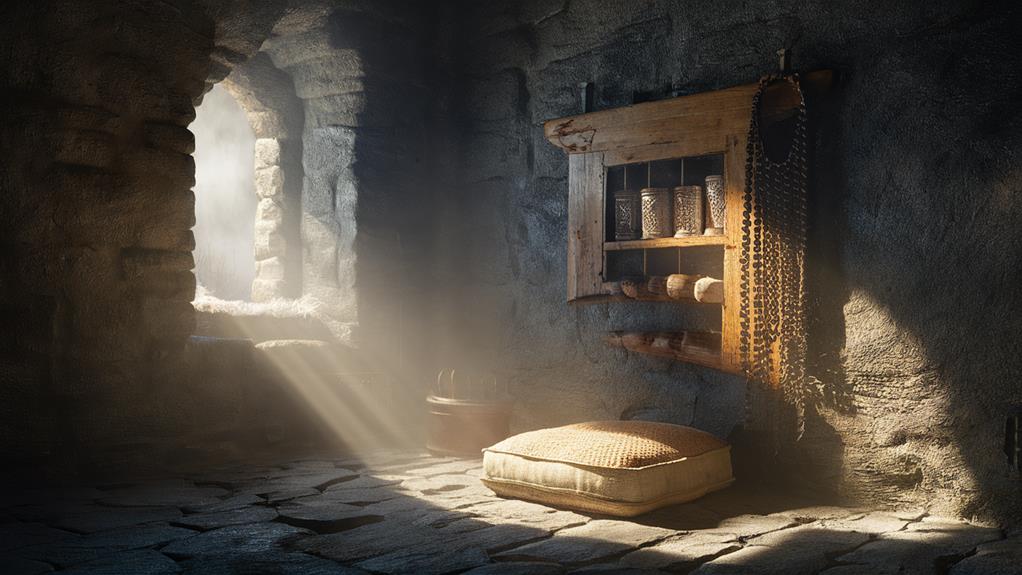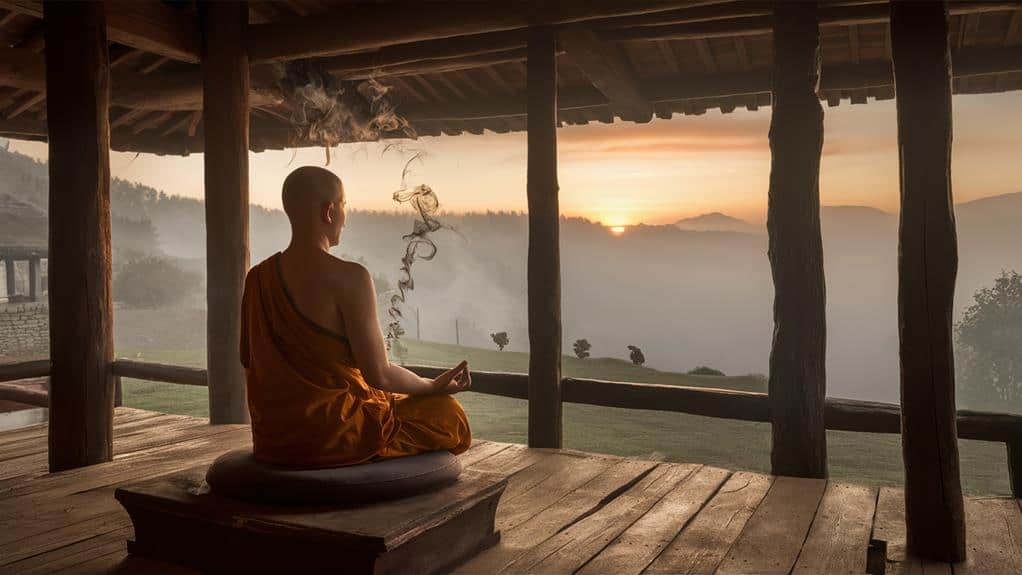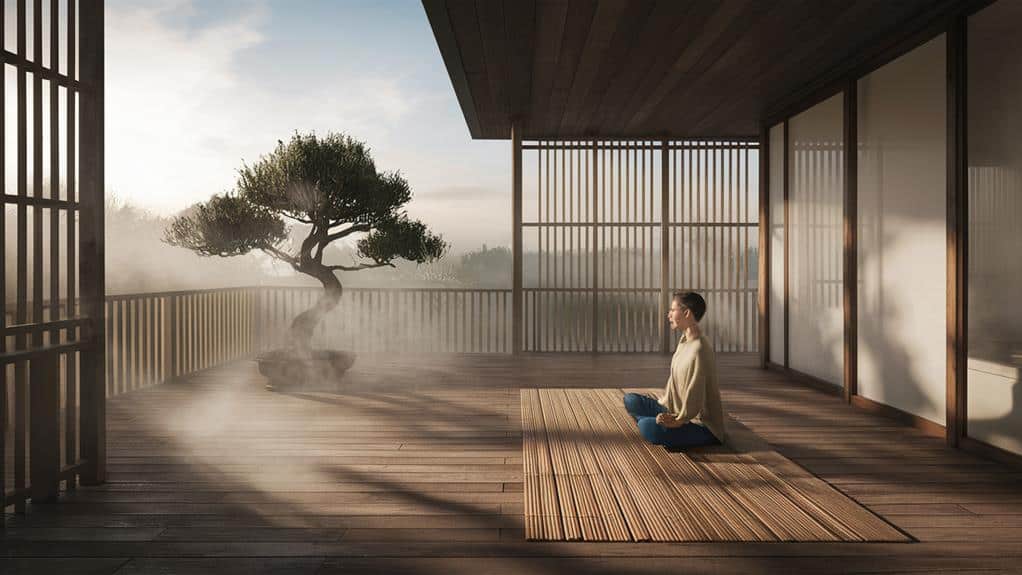The Role of Silence and Solitude in Mystical Practices
You’ll find that silence and solitude aren’t just absences—they’re gateways to profound spiritual transformation. Throughout history, mystics have retreated from the world’s constant chatter to discover deeper truths within themselves. From the stark deserts of ancient Egypt to the remote monasteries of Tibet, seekers have recognized that when external voices fade, something remarkable emerges. Whether you’re drawn to contemplative practices or simply curious about mystical traditions, understanding the power of sacred silence offers insights into how spiritual masters across cultures have accessed extraordinary states of consciousness. Let’s explore what happens when you dare to embrace the void.
Historical Roots of Sacred Silence

Throughout history, sacred silence has shaped spiritual practices across diverse cultures and religious traditions. You’ll find its earliest documented roots in ancient Egyptian temples, where priests maintained strict vows of silence to honor their deities.
In Buddhist monasteries, you’re encountering practices that have endured for over two millennia, where silence serves as a gateway to enlightenment.
When you explore medieval Christian monasticism, you’ll discover how Desert Fathers and Mothers sought divine connection through silent contemplation in remote wilderness. Their practices evolved into the structured “Great Silence” observed in Benedictine monasteries, where you’d experience complete stillness from evening until dawn.
You’re touching a tradition that’s influenced countless seekers, from Sufi mystics who’ve embraced silent meditation to Native American vision quests where you’d spend days in solitary silence.
These historical threads connect you to an ancient understanding: that in silence, you’ll find a universal language transcending cultural boundaries.
Whether you’re studying the Quaker’s silent worship or Zen’s mindful stillness, you’re participating in humanity’s timeless quest to access deeper spiritual dimensions through the practice of sacred silence.
Desert Fathers and Divine Solitude
In the harsh Egyptian desert of the third century, the Desert Fathers pioneered a radical form of Christian spirituality centered on solitude and contemplation.
These spiritual warriors withdrew from society’s clamor, choosing instead the vast emptiness where you’ll find nothing between yourself and the divine. They discovered that in absolute solitude, you’re forced to confront your deepest truths and shadow aspects that typically hide behind daily distractions.
You’ll recognize their profound influence in how they transformed isolation into a gateway for divine communion. Through their practice of hesychia – inner stillness – they’d sit in their cells for days, sometimes years, allowing the desert’s stark simplicity to strip away everything that wasn’t essential.
This radical surrender to solitude wasn’t about escape but rather intense spiritual engagement. When you remove society’s constant noise, you’re left with the raw reality of your existence – a state the Desert Fathers considered essential for genuine transformation.
Their legacy shows you that authentic spiritual growth often requires stepping away from the world’s endless chatter, finding in solitude’s embrace the space where your soul can finally speak its truth.
Buddhist Perspectives on Inner Stillness

While the Desert Fathers sought divine communion through physical isolation, Buddhist practitioners have developed their own profound understanding of inner stillness.
You’ll find that in Buddhist thought, true silence isn’t merely the absence of external noise but rather a state of mind where you’ve transcended the endless chatter of your thoughts. It’s a practice that doesn’t require you to retreat to remote caves or distant mountaintops, though you might choose to do so.
In Buddhist meditation, you’re invited to discover that inner stillness exists independent of your surroundings.
You’ll learn that what you’re seeking isn’t found in the forced quietude of isolation but in the space between your thoughts. This stillness reveals itself as you observe the mind’s activities without attachment, letting thoughts arise and dissolve like clouds in a vast sky.
When you cultivate this inner silence, you’ll notice that it’s always been there, hidden beneath the surface of your busy mind.
It’s a profound paradox: the more deeply you explore this stillness, the more you’ll realize it’s not something you need to create – it’s your natural state of being.
Sufism’s Silent Path
Mystics within the Sufi tradition have long understood silence as a sacred gateway to divine experience. In their pursuit of union with the divine, you’ll find that Sufis embrace what they call “khamushi” – the practice of inner quietude that transcends mere absence of speech.
Through this deliberate stillness, you’re invited to discover the whispers of your heart that often go unheard in life’s constant clamor. As you explore the Sufi path, you’ll encounter practices like “muraqaba,” where silence becomes your teacher and solitude your sanctuary.
You’re encouraged to let go of mental chatter and enter a space where wisdom flows not from external sources but from the depths of your own being. This isn’t just about finding peace – it’s about discovering the divine presence that Sufis say dwells within your heart’s chambers.
The silent practices of Sufism aren’t meant to isolate you from the world but to help you experience it more fully. When you’ve stilled your mind through “sukut” (spiritual silence), you’ll find that every breath becomes a conversation with the divine, and every moment holds the potential for profound awakening.
Modern Applications of Mystical Withdrawal

Today’s hectic world has sparked renewed interest in mystical withdrawal practices, with people seeking refuge from digital overwhelm and constant connectivity. You’ll find these ancient practices being adapted into modern retreats, meditation apps, and urban sanctuary spaces where you can disconnect and rediscover your inner silence.
You don’t need to join a monastery to embrace mystical solitude. You can create sacred spaces within your home – a corner dedicated to meditation, prayer, or contemplative reading. By setting boundaries around technology and carving out daily periods of intentional silence, you’re participating in a tradition that spans cultures and centuries.
The modern application of mystical withdrawal isn’t about complete isolation but rather mindful separation. You might integrate micro-retreats into your daily routine: a morning meditation before checking emails, a mindful walk without your phone, or evening contemplation by candlelight.
These practices help you develop what mystics call the “inner witness” – that part of consciousness that remains steady amid life’s chaos. Through regular periods of withdrawal, you’ll discover that silence isn’t empty but rather filled with profound insights and deeper awareness of your authentic self.
Psychological Benefits of Sacred Solitude
Countless studies have shown that sacred solitude practices provide measurable psychological benefits, from reduced anxiety to enhanced emotional regulation. When you engage in contemplative solitude, you’ll discover that your mind gradually settles into a state of profound stillness, allowing buried insights to surface and emotional wounds to begin healing.
This intentional withdrawal from external stimuli creates a sanctuary where your psyche can process, integrate, and restore itself. You’ll find that regular periods of sacred solitude strengthen your capacity for self-awareness and emotional resilience.
In these quiet moments, you’re able to observe your thoughts without attachment, developing a witness consciousness that serves as an anchor during life’s turbulent times. The neural pathways associated with mindfulness and emotional regulation become more robust through consistent practice, leading to lasting changes in how you process stress and maintain inner equilibrium.
As you cultivate this relationship with silence, you’ll notice enhanced clarity in decision-making, deeper access to intuitive wisdom, and a greater sense of wholeness. The psychological architecture of your mind transforms, creating space for both profound insights and everyday practical solutions to emerge naturally.
Digital Age and Contemplative Practice

The digital revolution presents three distinct challenges for modern contemplative practice: constant connectivity, information overload, and algorithmic distractions.
You’ll find your contemplative moments increasingly interrupted by notifications, while your mind struggles to settle into the deeper waters of silence amidst the perpetual digital current.
Yet you needn’t abandon your spiritual practice in this hyperconnected era. Instead, you can transform these challenges into opportunities by creating intentional digital boundaries.
You might designate specific rooms or times as “device-free sanctuaries,” where you’ll embrace the ancient wisdom of silence without the subtle pull of screens.
Consider how your ancestors found sacred solitude without technological interference – their path remains accessible to you.
When you do engage with digital tools, you can approach them with mindful intention, recognizing how they’re shaping your consciousness.
You’ll discover that periodic digital fasts can reset your nervous system, allowing you to experience contemplative depths that often remain hidden beneath the surface of constant connectivity.
The key lies in establishing a harmonious relationship with technology while preserving the sanctity of your inner silence.
Creating Sacred Silent Spaces
Sacred spaces emerge from intentional design, whether you’re transforming a spare bedroom into a meditation sanctuary or carving out a quiet corner in your garden.
You’ll find that the process of creating such spaces requires careful attention to elements that promote stillness: soft, natural lighting; minimal décor; and surfaces that don’t compete for your attention.
When you’re establishing your sacred silent space, consider incorporating elements that ground you in the present moment – perhaps a single candle, a meaningful symbol, or a simple cushion that invites you to settle into contemplative practice.
You’ll want to minimize external distractions while maximizing the elements that draw you inward. Natural materials like wood, stone, or fabric can help create a sensory environment that supports your journey into silence.
Remember that your sacred space needn’t be large; what matters is its capacity to hold silence.
You might find that even a windowsill adorned with a few carefully chosen objects can become a powerful anchor for contemplative practice.
The key lies in creating boundaries that separate this space from the ordinary world, allowing you to step into a different state of consciousness when you cross its threshold.
Integrating Stillness Into Daily Life

While sacred spaces provide dedicated environments for contemplative practice, integrating stillness into your everyday routine requires a more fluid approach. You’ll find that moments of quiet reflection can emerge naturally throughout your day – during your morning coffee, your commute, or even while washing dishes. These ordinary intervals become portals to deeper awareness when you consciously embrace them.
Begin by identifying natural pauses in your daily rhythm where you can temporarily step back from the world’s constant demands. You’ll discover that stillness doesn’t require perfect conditions; it’s available in the brief spaces between activities, in the gentle shift from one task to another. Let your breath become an anchor, drawing you into these moments of conscious quiet.
Consider establishing micro-practices – those fleeting instances when you can close your eyes, feel your feet on the ground, and reconnect with your inner silence. You might pause before entering a meeting, take three conscious breaths before checking your phone, or simply observe the play of sunlight through leaves during your lunch break.
These small acts of mindful presence gradually weave stillness into the fabric of your daily experience.









